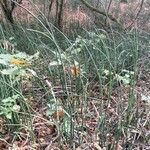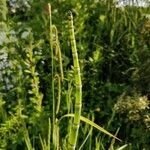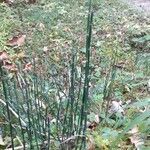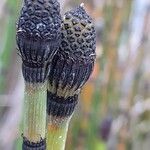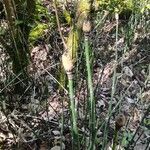Stems all alike, evergreen, mostly unbranched, ± erect, 2–15+ dm, 4–14 mm thick, with mostly 16–50 broad, rounded, roughened ridges; central cavity at least 3/4 the diameter of the stem, much larger than the small vallecular ones; stomates in 2 rows in each furrow; sheaths mostly 5–15 mm, black-banded at the tip and usually also at or near the base, the dark, scarious-margined, basally connate teeth articulate to the sheath but tending to be irregularly subpersistent; cones short-pedunculate, 1–2.5 cm, evidently apiculate. Streambanks and other moist or wet places; circumboreal, s. in Amer. to Fla., Calif., and C. Amer. Amer. pls are var. affine (Engelm.) A. A. Eaton (E. affine; E. prealtum; E. robustum)
An evergreen rush. It grows 1.2 m high. The stems are hollow and do not have leaves. They have 14-40 ridges along them. There are cones at the tips. These are 1-2 cm long. These are pointed.
Subspecies 2 (1 in the flora): North America, Mexico, Central America in Guatemala, Europe, Asia.
